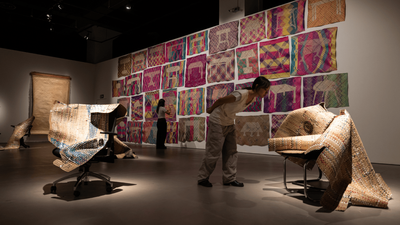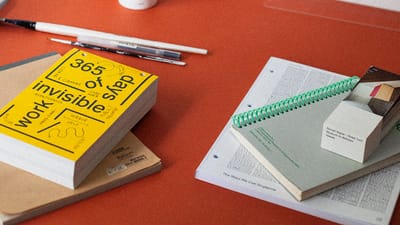First appearing in an 1836 map, where it was mangled as “Brass Bassa Road”, Bras Basah Road is still misspelt from the Malay beras (“harvested rice, with the husk removed”), while basah means “wet” or “soaked”. The riverbanks of Sungei Bras Basah were where wet rice from trading boats was spread out to dry; it’s now the paved-over Stamford Canal, parallel to Stamford Road. This was a rather risky place for unattended beras: the high tide once flooded over, resoaking them. In 1850, the road was blocked for two hours by the “many vicious cows” pasturing there with their calves.
Today, Beras/Brass/Bras Basah is known for its hotels, schools, shopping and dining establishments, Bras Basah Complex, and the trying-very-hard “Bras Basah.Bugis (BBB) precinct”. Since late last year, another entry—much more poetic and deliberately humorous—can be added to this palimpsest of place-naming: M Raihan Halim’s “La Luna”. The Singaporean director’s sophomore film is set in Kampung Bras Basah and traces how a lingerie store opens and shakes up that “sleepy and passionless” village, as the press notes called it.
The fictitious kampung is also idyllic and charming, but conservative and, to some, stifling. In the film’s jaunty opening sequence, we can’t help but notice its gender-segregated bus stops, framed by banana and coconut trees; magazines hanging old school-style in a kedai, with their cover models’ immodest skin and hair blacked out; and “Allah sentiasa melihat” (“God is watching”) signs everywhere. In a speeding car, schoolgirl Azura (Syumaila Salihin of the vilified “Mentega Terbang”) is railing to her single father, Salihin Arshad, about how things in their kampung never change. She has been caught doodling a caricature of the village’s chief, Tok Hassan (a snarling, chain-smoking Wan Hanafi Su, from “Apprentice”), as part of a petition against him. “Who gave him the power to decide what we can read, hear, and see in this village? That’s fascist, Dad!” Azura declared. Her impressive poster portrays Tok Hassan as the devil, tongue sticking out like a tyrant lizard king.
Exasperated, police chief Salihin lectures his daughter on the kampung’s laws. Instead of acting out, she should have filed the petition with the village committee. From there, the committee would have discussed its merits and decided whether to pass a motion—this is the proper, only way of effecting change. But, as it becomes painfully clear, the committee of “middle-aged Malay men”, including Salihin, is dominated by Tok Hassan, who has put in place a compliant uztaz, Fauzi, to ensure total obedience in his fiefdom. So much for checks and balances.
Kampung Bras Basah is the kind of rural community where all the villagers gather to watch the latest mobile cinema show and gawk at a newcomer. And what an insider-outsider she is. Worldly, hip hop-loving Hanie Abdullah has inherited her grandfather’s house there and decides to turn it into the titular lingerie store. The luminous Sharifah Amani, renowned for her collaborations with the late Malaysian director Yasmin Ahmad, embodies Hanie as only she can: a steadfast moralist, radiantly strong yet playful and vulnerable, unafraid of being fierce or coquettish. When the villagers come to stare at her and her shop’s makeover, Hanie, strikingly sans tudung in public, hams it up for their mobile-phone cameras like a cheeky rock star, one strap dangling off her denim dungarees. She “put[s] the ‘bra’ in Bras Basah”, reviewer Whang Yee Ling ventured.
It is not only here, in “one of the strictest villages in the country”, that Hanie’s emboldened entrepreneurship attracts attention, positive or not. Her previous women’s underwear shop was in Doha, which Tok Hassan invokes like it’s a lawless, morally bankrupt site of Islam, and was burnt down by fundamentalists. Hanie carries the emotional baggage, and literal scars, from this attack, which only makes her more resolute in recreating this safe space (“no men allowed”, a door notice states) and remounting the giant, billboard-like shop sign. La Luna, she confides in Salihin over takeaway kopi, is named after the moon because she wants the store’s neon sign to shine brightly throughout the night, like “a beacon of hope” for downtrodden women.
“How can a lingerie store—with the lacy negligees and leopard-print products—threaten a society so much that they would raze the shop to ashes?” Raihan asked in his director’s note. The veteran TV writer and award-winning director was inspired by a real-life arson case of such a shop in the Middle East to make “La Luna”. “What is society afraid of?” Raihan continued. “Change. Change can be a scary thing.”
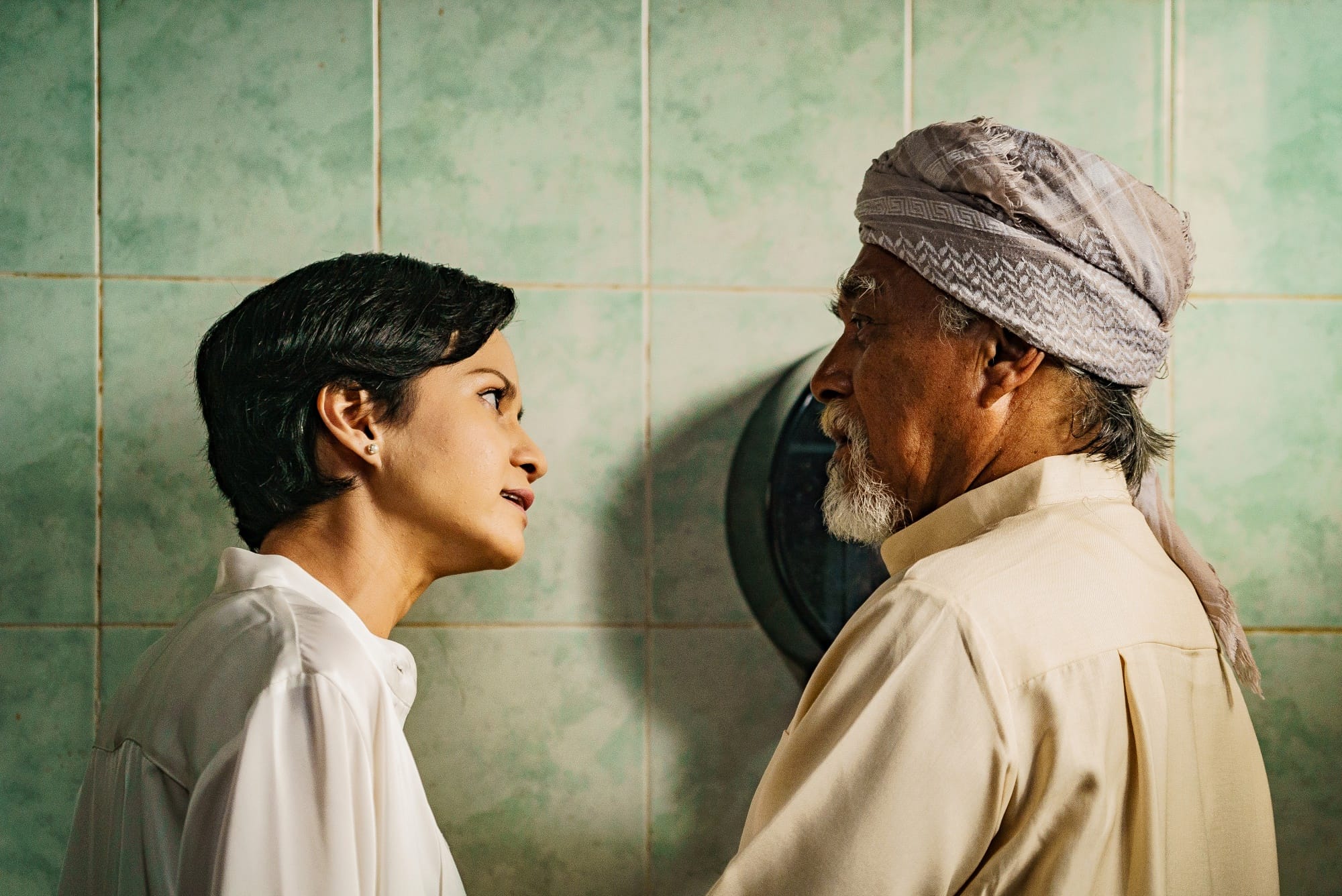
Singapore’s change from merger to separation, with the Federation of Malaya and Malaysia, was another scary, violent, and tearful event. That melodrama of 1963–65, orchestrated by Lee Kuan Yew, Tunku Abdul Rahman, the British, and others, intertwined with the decline of the Golden Age of Malay Cinema here. In 1964, the legendary multihyphenate P Ramlee returned to Malaysia (he was born in the Penang of British Malaya), perhaps spurred by clashes between Lee’s government and trade unions that complicated filming with Shaw Brothers, the studio he was contracted to. Loke Wan Tho, chairman of rival production company Cathay-Keris Studio, died in a plane crash in the same year. Nationalistic tensions arising from separation, and the untimely death of auteur Hussain Haniff (“Hang Jebat”) in 1966, aged 32, further spelt the end. Shaw’s Malay Film Productions shuttered in 1967; Cathay-Keris in 1973.
It would take four decades, long past the revival of Singapore cinema in the 1990s, before another Malay fiction feature would emerge. Sanif Olek’s “Sayang Disayang”, a sensual two-hander between an Indonesian caregiver and dyspeptic widower, was released in 2013 and went on to represent Singapore at the Oscars. Raihan’s own debut “Banting”, an effervescent dramedy of a tudung-wearing aspiring wrestler, screened a year later at the Hawaii International Film Festival. Producer-educator Jeanine Lim pointed to the equally paltry state of Tamil filmmaking in post-independence local movies, which have a “fragmented cultural identity” and are “Chinese-dominated”. From the heydays of P Ramlee’s “Bujang Lapok” series (1957–61) and the “Pontianak” trilogy (1957–58), and even the embers of a novelty film like “Mat Bond” (1967), we now have yet another Jack Neo sequel to look forward to. “For a cinema viewer who would know Singapore only through its movies,” Raphaël Millet wrote in Singapore Cinema, “it would have seemed like the country’s population changed from Malay to Chinese overnight.”
Watching “La Luna” in local cinemas and regional Netflix, I recalled this cinematic heritage of Malaya, Singapore, and Malaysia, one nearly as possessively contested over as the origins of certain food dishes. The Singapore-Malaysia co-production is written and directed by a Singaporean, acted by mainly Malaysian actors (even homegrown Hisyam Hamid, of “Revenge of the Pontianak”, is Kuala Lumpur-based), and is ostensibly set in Malaysia (ringgit is used, with kueh, in a bribery scene; there’s mention of KL)—though which country Kampung Bras Basah belongs to is never explicitly stated. Raihan himself noted that his audience found that the film “feels like a Malaysian film, but slightly off kilter. Something about it doesn’t feel Malaysian.” As a transnational, or at least cross-Causeway, movie, could the dual-nationality “La Luna” possibly be set in a Malaysia of now that had never separated from Singapore? Or even a Singapore that had never left Malaysia?
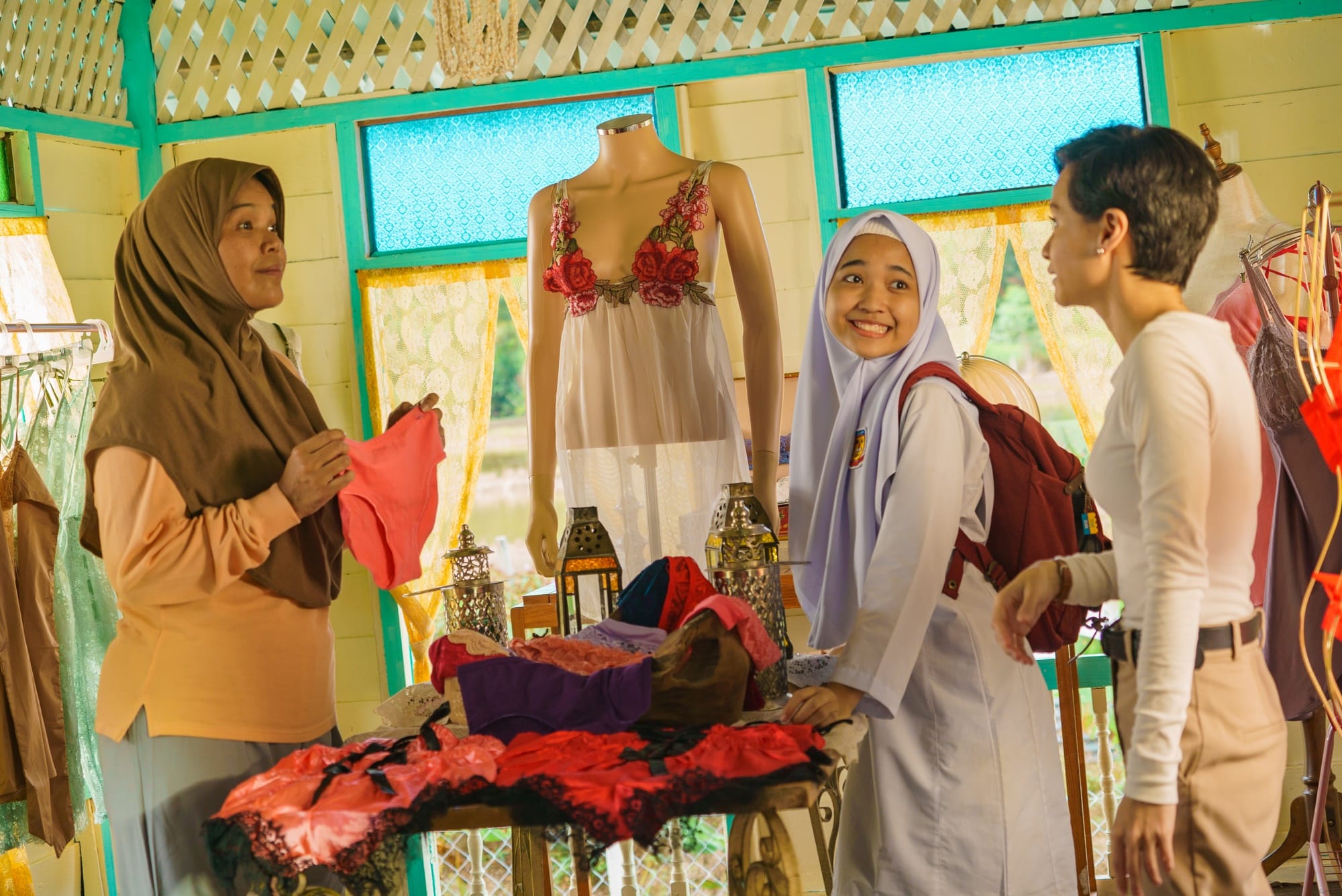
Hanie’s bohemian store, more La Senza than Triumph, brings about exciting change to a village in stasis. After a tentative reception (“Who would even buy [this]?” one townsfolk asked), Hanie’s business fortunes dramatically rise when long-married couple Ayob (actor-director Nam Ron) and Enah discover the joys of sexy lingerie. Thanks to a slinky red pair, Enah, brought to electric life by Farah Ahmad, goes from demure cik to va-va-voom vamp. Ayob is awakened from his late-night slumber to find her, bra strap peeking out of her baju butterfly, pounding and grinding a pestle and mortar to make supper. “Abang”, she breathes at the dazed man, wiping off full beads of sweat under her Diana Ross hair, “lapar?” (“Dear, are you hungry?”) Two words that invite him to sate his hunger and horniness.
Their sexual re-awakening cannot be contained. First, their teenage son, Yazid, unluckily walks in on their bedroom lovemaking. Then, it spills over into Kampung Bras Basah when they accidentally broadcast it from the AV room of the village headquarters. Cutting to reaction shots of jaws dropping, their public display of affection is soundtracked by the climactic waltz of “The Blue Danube”. Raihan portrays intimacy in a chaste, Hays Code-adherent manner; the innuendos only make the raunchiness funnier, more taboo-breaking by leaving it to the imagination. (“La Luna” received an age classification of 13 in Singapore and 16 in Malaysia after two aural edits—alas, it still received religious criticism in the latter.)
The community’s rush to snap up Hanie’s lingerie incurs the full-blown wrath of Tok Hassan. The village chief unleashes his feudal forces upon the city slicker: from quietly threatening her, he rewrites a sermon of Ustaz Fauzi to condemn her and her store as signs of Satan “hid[ing] among us”. Tok Hassan employs that classic slippery-slope argument in trying to run our heroine out of town: if we allow this perversion, what comes next? Legalising gay marriage? A female imam?
When Uztaz Fauzi receives Tok Hassan’s edits to his humanist sermon—with exaggerated red strikethroughs like an over-conscientious Singapore teacher’s marking—the joke- and story-loving cleric can only mumble, “Tok. This sermon seems to be attacking the shop.” Initially compliant, Iedil Dzuhrie as the meek religious teacher learns to stand up for himself in God’s, and not a tyrant’s, name.
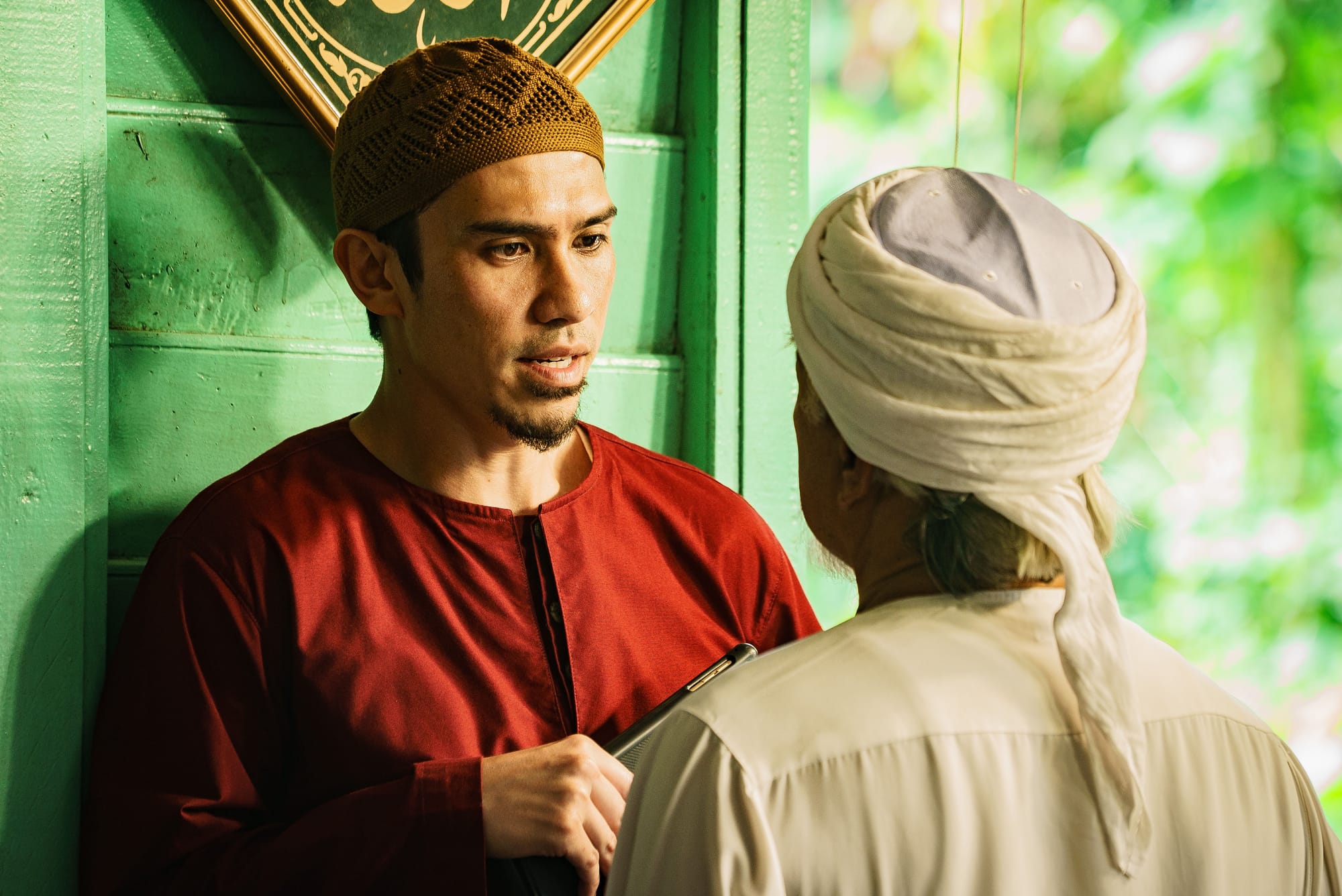
As a microcosm of mishmash societies, Kampung Bras Basah is a place that is evocatively hybrid and anachronistic. The characters’ mobile devices point to a contemporary timeframe, but the décor (courtesy of art director Min Mohamed), all frilly curtains, flowery sofa, and a cathode-ray tube antenna television with doily, is wonderfully retro. Open-air screenings of movies are still called “wayang”; Salihin, especially, is prone to stumbling over English words (“What do Westerners say?”). It’s a village cosmopolitan enough for Azura to crave her arty films, yet where Hanie is sentenced to the public shaming of picking litter (Corrective Work Order, anyone?) for simply entering a male toilet for an emergency confrontation with Tok Hassan. I leaned towards this being more of a Malaysia, though, because as that damned Singaporean in me observed: none of the citizens are clamouring for home upgrading, en bloc, or condos on the padi fields. Azura, Hanie, and so many others latently just want “positive change”, as Salihin terms it.
I admire how “La Luna” sets up this olde-modern village not for cheap nostalgia, or empty gotong royong sentiments. Rurality here is where a certain brand of fascism can take hold of a cloistered community over time, but also where individuals can pop into each other’s homes and, compelled by a single catalyst, quickly band together to shake off the yokes of yore. Similarly, my Malayan daydreaming is not to romanticise the challenging, uncertain times of geopolitical identity formation, but to remember how borders between formerly united political entities, and their rakyat, seemed to be more porous then. Raihan’s own childhood speaks to these overlapping histories and inspirations: his late grandfather was from Malacca, and Raihan credited him for his artistic leanings.
Whether it’s images from Boo Junfeng’s short film “Happy and Free” (2013), like the Malaysian flag draped from HDB blocks, or the photograph that writer Alfian Sa’at recollects of Nantah school choristers in batik uniforms (as he recounts in Raffles Renounced), certain pictures retain powers beyond their immediate time. “La Luna” itself highlights the power of art, including sound and moving images, in dismantling power structures: it is in the AV room, that chamber of magic usually reserved for Tok Hassan’s severe pronouncements, where he later comes undone.
Though he nods to P Ramlee’s “Tiga Abdul” (1964) in the love-hate romantic tension between Salihin and Hanie, and adopts the monocultural nature of the Golden Age’s on-screen talents, it is not that impossibly heavy mantle that Raihan’s film inherits. Rather, he goes beyond the anxiety of influence, and market forces, to filmically extend the humanist spirit of Yasmin Ahmad to our shores. As Alfian wrote of the Malaysian director: “Yasmin Ahmad became the voice we’d been waiting for. It was a voice that spoke to, and for, a generation of young Malay Singaporeans underserved by a Sinocentric local media, who found very little we could relate to in the country of our birth.”
Yasmin’s films foregrounded the family and everyday settings as sites of potential openness and plurality, and love as transformative. There is, of course, the immortal “Sepet” (2005), with its Malay-Chinese romance. Pertinent to “La Luna” is her first film, “Rabun” (2003), which dispels romantic notions of the kampung. An elderly, loving couple return to their village in the hopes of being surrounded by extended family and loving neighbours, but are swindled by a distant relative. Through this disappointment, the film ends on a tender note of hope for reconciliation, later also enacted in “Muallaf” (2008).
Wearing this tribute on his sleeve with the casting of Sharifah Amani, Raihan pays homage to Yasmin’s slim but reverberating filmography most in the relationship between clingy father Salihin and his daughter who is beginning to date, where the father must learn to “accept this change” and let his child and society find their own way. Even if he doesn’t go as far as Yasmin did in tackling knottier issues like interracial and religious relationships and family abuse, “La Luna” returned to me the warm companionship of Yasmin’s films, a soft-spoken comradery built on smiles through hardships, and forgiveness and understanding, if not a Malayan subconsciousness.
This progressive space she created across the Nusantara, which Raihan and others expand, may look like “an imagined community”. But I think it’s really a “dreamed community”, in the words of the late Benjamin McKay, long-time critic of Malaysian film. Kampung Bras Basah may be a fictive, dreamed-up community, but these visualisations of hopes of change do reflect “optimistic possibilities” for a future we are collectively dreaming into being. As humourist Colin Goh of “Singapore Dreaming” succinctly put it, this is “a community we all desperately wish existed”. Filmed in the royal town and padi fields of Perak’s Kuala Kangsar, Raihan’s film summons Yasmin’s generous spirit, who exemplifies—and from whom he inherits—not just a Singapore dreaming but a Malayan one. As Raihan wrote in his director’s statement, “For me, ‘La Luna’—the film and the lingerie shop itself—are about challenging traditions and changing our lives…from the inside out”. Long live Kampung Bras Basah.
This essay was completed under the ArtsEquator Fellowship. Views expressed are solely of the writer/creator.
Dan Koh is a writer (Jurong, My Love), book editor, and film producer whose website is damnkohl.com.
“La Luna” is streaming on Netflix Singapore.
If you enjoy Jom’s work, do get a paid subscription today to support independent journalism in Singapore.
Letters in response to this piece can be sent to arts@jom.media. All will be considered for publication on our “Letters to the editor” page.



